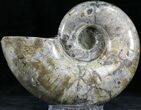This Specimen has been sold.
6.1" Polished Anapuzosia Ammonite Fossils - Iridescent
This is a thick, 6.1" wide Anapuzosia ammonite collected in the Mahajanga Province of Madagascar. The exterior has been highly polished and you can see the beautiful suture patterns just beneath the translucent shell. An absolutely gorgeous specimen, of a type not as frequently seen for sale.
This specimen has some natural iridescent hues when viewed at the right angle.
This specimen has some natural iridescent hues when viewed at the right angle.
About Ammonites
Ammonites were ancient marine cephalopods, similar to today's squids and octopuses, but with a defining feature: their distinctive, tightly coiled spiral shells. These shells, resembling those of modern nautiluses, served as both a protective home and a buoyancy aid, allowing ammonites to navigate the prehistoric seas with ease. First emerging around 240 million years ago in the Triassic Period, ammonites thrived for over 175 million years, adapting through numerous forms and sizes. As predatory creatures, they likely fed on smaller marine organisms, using their tentacles to capture prey. However, their long reign came to an end 65 million years ago at the close of the Cretaceous, coinciding with the mass extinction event that also eliminated the dinosaurs.
Ammonites were ancient marine cephalopods, similar to today's squids and octopuses, but with a defining feature: their distinctive, tightly coiled spiral shells. These shells, resembling those of modern nautiluses, served as both a protective home and a buoyancy aid, allowing ammonites to navigate the prehistoric seas with ease. First emerging around 240 million years ago in the Triassic Period, ammonites thrived for over 175 million years, adapting through numerous forms and sizes. As predatory creatures, they likely fed on smaller marine organisms, using their tentacles to capture prey. However, their long reign came to an end 65 million years ago at the close of the Cretaceous, coinciding with the mass extinction event that also eliminated the dinosaurs.
SPECIES
Anapuzosia sp.
LOCATION
Ambatolafia, Mahajanga Province, Madagascar
SIZE
6.1" wide
CATEGORY
SUB CATEGORY
ITEM
#25205
We guarantee the authenticity of all of our specimens.
 Reviews
Reviews














